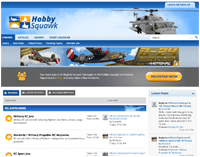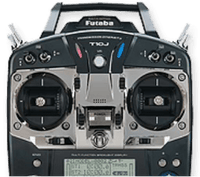How To Land Your R/C Model Airplane
by Todd BredaThere's a saying in the world of flight:
Takeoffs are optional. Landings are mandatory.
Indeed, once you are airborne, the only mandatory part of your flight is the landing (hopefully successfully and in one piece). I've always said a bad landing can ruin a good flight. Executing a great landing isn't only a good way to keep your aircraft and it's landing gear happy, it's immensely rewarding and a great way to end a nice flight.
So today I am going to walk you through the secrets to execute a successful landing. For simplicity sake I will use a high wing trainer with tricycle gear as my example, however these same principles apply to any model aircraft.
First off let's talk about the flying pattern. This is the rectangular flight path comprised of segments known as "legs". When you take off into the wind this is called the "Departure (or Upwind) Leg". When you turn perpendicular to the wind this is called the "Crosswind Leg". When you turn again, now in the direction and parallel to the runway this is known as the "Downwind Leg". Once a safe distance past the runway another turn perpendicular to the wind towards the runway is called the "Base Leg". And finally, the turn back into the wind heading directly to the runway is called the "Final Approach".
Here's a visual diagram for reference:

Now that we have discussed legs within the runway pattern, let's move on and talk about setting your model up for the perfect landing.
Let's assume you are already flying the pattern. If your model has retracts and you are ready to land, I like to drop my retracts on the upwind leg to adjust for any CG shifts.
Now that the model has her "feet" down and locked you want to make sure your downwind leg altitude is approximately 30 or 40 feet AGL (Above Ground Level). This is of course variable based on conditions and environment but 30 or 40 feet AGL is a decent altitude as we approach our setup for landing.
If you have flaps I tend to drop my first setting of flaps (half flap) on the tail end of the downwind leg. As you turn on to the base leg you want to begin decreasing your power by dropping your throttle accordingly. If you have flaps and there isn't a really strong head wind, go ahead and drop your flaps to their full flap setting.
Tip: Always remember, you adjust your power to increase/decrease altitude. Elevator (pitch) is adjusted to change your model's Angle of Attack or attitude in relation to the horizon. Using elevator primarily to drop or increase altitude decreases or increases airspeed which can get you in all kinds of trouble.
By decreasing your power your model will begin to lose altitude. You want to do this gradually to keep your model on a consistent - not drastic - glide slope. The goal is to enter your final approach at a safe but lower altitude so you are not coming in too high and too hot.
Your power should generally be no more than 50% on the base leg, and when you begin your turn onto final approach your power should be adjusted for approximately 25% give or take, depending on variables such as wind, obstacle clearance, etc.
You should only be using your ailerons to turn (in conjunction with the rudder to keep your turns coordinated) and to keep your wings level. Other than that once you are on final approach your primary controls should be throttle, rudder and elevator (to flare at the end).
Once on the final approach use your rudder to keep your model pointed at the runway and use your throttle to control it's rate of descent. Elevator can be used to help adjust the attitude but again, power is what you should be using to control altitude.
As your model gets closer to the landing spot you want to gradually reduce power to help the plane settle and break through ground effect, a phenomenon close to the ground that wants to keep your model flying. Especially if flaps are engaged, you want to be careful not to slow the model down too much or you will hit stall speed. This is the point of the model's airspeed where the wings stop creating lift and your model will stall.
Tip: Always fly your model to the ground under power. While some models have excellent glide characteristics where you can "dead stick" (chop the throttle to idle) the landing, it's always good practice to land with power to avoid a stall.
So now that you are close to your landing location and your wings are level, the power is decreasing, your models nose should be horizontal to the ground or slightly angled a few degrees above the horizon. Be careful not to increase too much elevator when your power setting is so low to avoid a stall.
Once the bottom of your gear is approximately 6 inches or under to the surface, this is what I consider the safe "Flare Zone". This is where you can begin to slowly apply back pressure to your elevator while simultaneously reducing your airspeed even further. The goal here is to allow your main gear to touch down softly before the nose gear. The elevator at the flare stage is your key input to land softly and successfully. When your main gear first makes contact your nose attitude should be slightly nose high so the nose gear comes down only after the mains are down.
That's all there is to it! Of course, with anything, practice makes perfect so get on that simulator if you have one and practice, practice, practice.
Here's a sample video of myself demonstrating a quick takeoff and landing using these same principles:
Note: You will notice towards the end of the downwind leg I realize I am a little higher than I would like to be for my turn into the base leg so I reduced my power which allowed the model to drop altitude without increasing airspeed. I was then able to enter the base leg and final approach at a proper altitude for landing. You can hear my throttle management throughout the video.
I hope you find this landing lesson helpful to you and may you enjoy many successful flights and landings.
Happy Landings!
Get the latest from Motion RC sale and product announcements
You can unsubscribe at any time!
Freewing SR-71 Blackbird Twin 70mm EDF Jet With Gyro - PNP
SKU: FJ32211PG
- Deployable parachute activated by transmitter, for shorter, authentic landings
- Includes 3 decal sets for easy customization, or add your own personal touch
- EG01 gyro offers enhanced stability for a smooth flying experience
VIEW PRODUCT


Freewing Avanti S V2 80mm EDF Sport Jet - PNP
SKU: FJ21235P
- New color scheme picked by our customers
- New powerful motor and 12-blade fan
VIEW PRODUCT


Freewing F-16 V2 High Performance 90mm EDF Jet - PNP
SKU: FJ30631P
- 6S 3668-1960Kv Power System
- Scale, servo-actuated air brakes
- Quick release wings
VIEW PRODUCT


Freewing Eurofighter Typhoon 90mm EDF Jet - PNP
SKU: FJ31912P
- New for 2023 - Completely redesigned
- Functional scale air brake
VIEW PRODUCT


Freewing AL37 Airliner Twin 70mm EDF Jet - PNP
SKU: FJ31513P
- 11 pre-installed LEDs
- Giant scale size with 1980mm length
- Twin, 12-blade 70mm EDFs
VIEW PRODUCT


Freewing Universal Tail Flame Afterburner LED Lights for 80/90mm EDF Jets
SKU: E632
VIEW PRODUCT


FlightLine Spitfire Mk.IX 1600mm (63") Wingspan - PNP
SKU: FLW303P
- Grass capable landing gear with suspension struts
- Scale four panel split flaps
VIEW PRODUCT


Freewing F-22 Raptor 80mm EDF Jet with Gyro - PNP
SKU: FJ22311PG
- Stunning scale details with molded panel lines, rivets, and LED lighting
- Powerful 80mm EDF delivers smooth thrust and authentic jet-like sound
- Stunning scale details with molded panel lines, rivets, and LED lighting
VIEW PRODUCT


Freewing F-16 Falcon 64mm EDF Jet V2 - PNP
SKU: FJ11112P
- Modernized 64mm F-16
- ESC with reverse thrust
VIEW PRODUCT


Freewing F-22 Raptor High Performance 70mm EDF Jet – PNP
SKU: FJ22211P
- Quick release wings
- Super scale details throughout
- High performance 12-blade EDF
VIEW PRODUCT


Freewing Tail Flame Afterburner LED Lights for Select 80/90mm Freewing EDF Jets
SKU: E631
VIEW PRODUCT


Freewing F9F Panther 4S Blue 64mm EDF Jet - PNP
SKU: FJ10322P
- New 4S power system
- Navy blue livery
VIEW PRODUCT


Freewing F-16 V2 Ultra Performance 8S 90mm EDF Jet - PNP
SKU: FJ30632P
- 8S 4075-1350Kv Power System
- Servo-actuated air brakes
- Quick release wings
VIEW PRODUCT


Freewing Mirage 2000C V2 High Performance 80mm EDF Jet - PNP
SKU: FJ20635P
- New 80mm 12-blade ducted fan
- Hybrid metal gear servos throughout
VIEW PRODUCT


Prolux Digital LED Thermal Sealing Iron - 230V
SKU: PLX1365
- Adjustable temperature 100°C to 220°C (212°F to 428°F)
- LED indicators for power and heating status
VIEW PRODUCT


ZTW Backup Capacitor 25F 12V 25A
SKU: ZTW7002510
- Provides power to receiver in the event of BEC/receiver pack failure
- 6.0V-12.0V input voltage
- Up to 25A current output
VIEW PRODUCT


ZTW Backup Capacitor 25F 8.4V 25A
SKU: ZTW7002511
- Provides power to receiver in the event of BEC/receiver pack failure
- 6.0V-8.4V input voltage
- Up to 25A current output
VIEW PRODUCT


ZTW Backup Capacitor 60F 12V 25A
SKU: ZTW7006010
- Provides power to receiver in the event of BEC/receiver pack failure
- 6.0V-12.0V input voltage
- Up to 25A current output
VIEW PRODUCT


ZTW Backup Capacitor 60F 8.4V 25A
SKU: ZTW7006011
- Provides power to receiver in the event of BEC/receiver pack failure
- 6.0V-8.4V input voltage
- Up to 25A current output
VIEW PRODUCT


ZTW UBEC 30A HV Adjustable Output Voltage External BEC
SKU: ZTW3050010
- Adjustable output voltage of 5.2V-12V
- 30A continuous/60A peak current output
- Dual inputs for main and backup batteries
VIEW PRODUCT


ZTW UBEC 8A G2 Peak 15A Adjustable Output Voltage External BEC
SKU: ZTW3040011
- Adjustable output voltage of 5.0V-8.4V
- 8A continuous/15A peak current output
VIEW PRODUCT


ZTW Skyhawk 35A ESC with 8A SBEC
SKU: ZTW4035211
- 32-bit microprocessor controlled
- High Voltage SBEC
VIEW PRODUCT


Primus 1500mAh 2S 7.4v Li-ion Battery with T Connector
SKU: PRM6024-002
VIEW PRODUCT


Primus 1200mAh 2S 7.4V Li-ion Soft Battery with T Connector
SKU: PRM6024-001
VIEW PRODUCT



Hobby Squawk Community Forum
visit forum
RC Knowledge Blog
visit blog
Guidance & advice for beginners
Find out more








